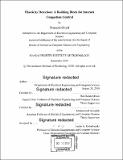Elasticity detection : a building block for internet congestion control
Author(s)
Goyal, Prateesh
DownloadFull printable version (6.966Mb)
Alternative title
Building block for internet congestion control
Other Contributors
Massachusetts Institute of Technology. Department of Electrical Engineering and Computer Science.
Advisor
Hari Balakrishnan and Mohammad Alizadeh.
Terms of use
Metadata
Show full item recordAbstract
This thesis develops a technique to detect whether the cross traffic competing with a flow is elastic or not, and shows how to use the elasticity detector to improve congestion control. If the cross traffic is elastic, i.e., made up of flows like Cubic or NewReno that increase their rate when they perceive available bandwidth, then one should use a scheme that competes well with such traffic. Such a scheme will not be able to control delays because the cross traffic will not cooperate to maintain low delays. If, however, cross traffic is inelastic, then one can use a suitable delay-controlled algorithm. Our elasticity detector uses an asymmetric sinusoidal pulse pattern and estimates elasticity by computing the frequency response (FFT) of the cross traffic estimate; we have measured its accuracy to be over 90%. We present the design and evaluation of Nimbus, a congestion control protocol that uses the elasticity detector to switch between delay-control and TCP-competitive modes. Our results on emulated and real-world paths show that Nimbus achieves throughput comparable to or better than Cubic always, but with delays that are much lower when cross traffic is inelastic. Unlike BBR, Nimbus is fair to Cubic, and has significantly lower delay by 40-50 ms. Compared to Copa, which also switches between a delay-controlling and a TCP-competitive mode, Nimbus is more robust at correctly detecting the nature of cross traffic, and unlike Copa, it is usable by a variety of delay-based and TCP-competitive methods.
Description
Thesis: S.M. in Computer Science and Engineering, Massachusetts Institute of Technology, Department of Electrical Engineering and Computer Science, 2018. Cataloged from PDF version of thesis. Includes bibliographical references (pages 61-64).
Date issued
2018Department
Massachusetts Institute of Technology. Department of Electrical Engineering and Computer SciencePublisher
Massachusetts Institute of Technology
Keywords
Electrical Engineering and Computer Science.